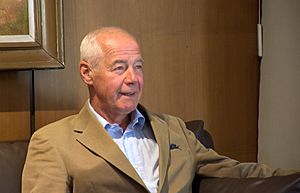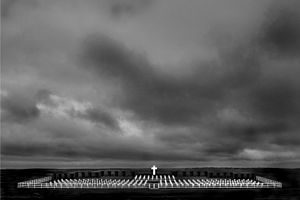Geoffrey Cardozo facts for kids
Quick facts for kids
Geoffrey Cardozo
|
|
|---|---|
 |
|
| Born | 3 March 1950 |
| Service/ |
British Army |
| Rank | Colonel |
| Unit | 4th/7th Royal Dragoon Guards |
Geoffrey Cardozo CBE, born on March 3, 1950, is a former British Army Colonel. He is well-known for his important work in helping to identify the bodies of Argentine soldiers. These soldiers were buried in the Argentine Military Cemetery in the Falkland Islands after the Falklands War. Many of their graves were marked "Argentine soldier only known to God" because the Argentine government at the time did not help identify them. In the Army, he was part of the 4th/7th Royal Dragoon Guards.
In November 2020, Geoffrey Cardozo was nominated for the 2021 Nobel Peace Prize. He was nominated alongside Julio Aro, an Argentine veteran from the Falklands War. They worked together to use DNA to identify the soldiers' remains in the cemetery.
Geoffrey Cardozo is the son of Frederick Cardozo, who was also a British Soldier. He also served as Secretary of Veterans Aid, an organization that helps military veterans.
Helping at Darwin Cemetery
After the Falklands War, Colonel Cardozo went to the Falkland Islands. He was a specialist in post-traumatic stress disorder (PTSD) and could speak Spanish. His first job was to support soldiers and check how they were feeling. As military engineers cleared landmines from the island, they often found bodies. Cardozo would fly by helicopter to find these bodies. He would record where they were found and then bury them.
Later, Cardozo was given an official task. He had to find and bury the bodies of Argentine soldiers scattered across the island. He also had to create a special cemetery for them. A farmer named Brooke Hardcastle donated the land for this cemetery. To help with this big job, Cardozo went back to London. He put together a team of twelve men to assist him in the Falklands. They returned and began the burial work in January 1983.
Cardozo found between 230 and 246 bodies. For those he could identify, he made sure their gravestones had their personal details. For the 122 soldiers he could not identify, Cardozo made a special decision. He carefully buried them with any personal items he found. He hoped this would help identify them someday. He wrapped the bodies in three layers: sheets, plastic, and PVC bags. He also included a note describing where each soldier had been found. These were then placed in wooden coffins. The burial work finished on February 19, 1983, about ten months after the war ended. He worked with the Commonwealth War Graves Commission to build the cemetery.
Afterward, he wrote a detailed report about his work. He sent this report to the Red Cross. The Red Cross then sent it to the British Government, who passed it to the Argentine government. However, the families of the Argentine soldiers were not told about this important document for a long time.
Identifying the Soldiers
In 2018, an Argentine war veteran named Julio Aro visited the Darwin Cemetery. He then traveled to London to find British veterans who could share information. There, he met Geoffrey Cardozo, who helped him as a translator. Cardozo gave Aro a copy of his reports. These reports showed the exact locations of the bodies in the cemetery. This information became very important for using DNA to identify the Argentine soldiers' remains in 2017.

Soon, a big effort began to identify the soldiers. Julio Aro started a foundation called No Me Olvides (Don't Forget Me). Geoffrey Cardozo and journalist Gabriela Cociffi joined him. They also received help from Roger Waters, a musician. He used his meeting with then-president Cristina Fernández de Kirchner to encourage more public support for the search. However, there was not much progress under the Kirchner governments. They did not discuss the matter with the British government. The real breakthrough happened with the government of Mauricio Macri. They signed the Foradori/Duncan agreement, which allowed the identification work to move forward.
Awards and Recognition
In 1984, Queen Elizabeth II appointed Cardozo a Member of the Most Excellent Order of the British Empire. This was a recognition of his service.
In 2009, he received a Mention of Honor from the Senate of Argentina. In 2018, the Argentine Embassy in London honored him. He was recognized alongside Julio Aro, Gabriela Cociffi, and Roger Waters.
In 2019, Queen Elizabeth II appointed him Commander of the Most Excellent Order of the British Empire. This higher honor was for his important work in improving relations between the UK and Argentina.
See also


